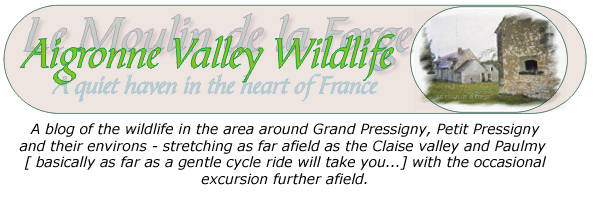Saturday morning I rescued a rather worn looking, female
Humming-bird Hawkmoth [
Macroglossum stellatarum]
Moro-Sphinx from the inside of the kitchen window.
 |
| This is one I took earlier.... 2006, actually! |
Their larval foodplants are bedstraws....
here we have the biggest of the lot...
Goosegrass or
Cleavers [
Gallium aparine]
Gaillet Gratteron.
I wish it wasn't so abundant....
it pulls my young trees over....
and then buries them completely...
so I released her where there was a patch that is unlikely to get the chop in the "foreseeable".
She immediately began to lay...
it was fascinating to watch...
I thought she was feeding at first....
but it dawned quite quickly that she was hovering mainly at the unopened tips.
She would hover up and down a tip...
decide it wasn't right, or too small...
then move to another.
If it was deemed suitable, she laid an egg...
by dabbing her tail against the underside of a leaf about two inches lower...
she chose nice fat tips...
presumably with plenty of growth to come.
I will keep an eye open on that patch....
On the subject of laying eggs, the daft
Fox Moths have been at it again....
laying on the edge of the door frames....
 |
| Rather like little eyes... or perhaps humbugs? |
and another, an
Ubu moth [
Unknown because unseen], laid a batch of eggs directly on the glass...
 |
| Little round marbles... |
they seemed to be doing nothing and....
as they were in full sunlight...
I thought they'd probably cooked...
and then, just as Pauline and I were going out...
I noticed each one had a black dot....
"I'll photograph that later", thought I...
on our return...
they'd almost completely hatched out.
 |
| All hatched out.... |
These pix give some idea of the hatching out process...
some of them crawled away...
others abseiled down the three feet on home-spun silk!
 |
| ...and almost all gone!! |
Now all that is left is the burst bubblewrap!!
 |
| They were leaving silk trails before they left the vicinity of the egg mass!! |

























